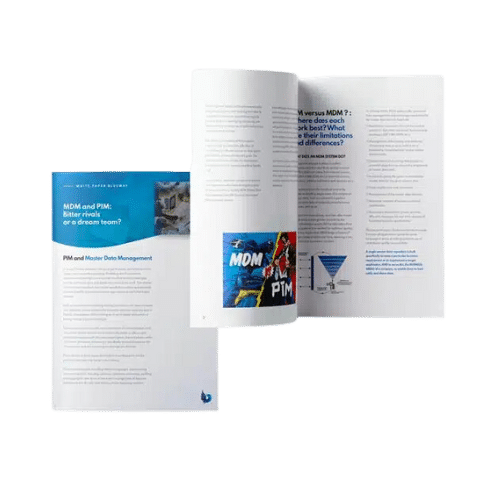The omnipresence of data in all areas of corporate strategy nowadays has to be acknowledged, and with it the need to install Master Data Management (MDM) or Product Information Management (PIM) systems to take full advantage. The adage about providing “the right information to the right person at the right time” has never been so relevant.
In a world where control over data is becoming essential to actively contribute to development strategies while decision-making circuits continue to shorten, IT and business departments have to work together increasingly closely to deliver reliable, secure data management solutions.
Regardless of your sector of economic activity, your customers, partners and employees are now hyper-connected and will increasingly need to exchange data in real time. It would be as well to get organised right away, to leverage value from your data and create master data repositories for business uses, such as pushing personalised promotions to customers based on an analysis of their past purchases, or optimising logistics routes using an analysis of all trips using IoT sensors. The applications are almost endless and they all further business performance.
To this end, IT departments must first unify all their data within shared master data repositories, as this will facilitate the manipulation and secure distribution of data within any internal or external ecosystem. MDM (Master Data Management) and PIM (Product Information Management) solutions appear to meet the requirements, but how similar are they and where do they differ? Why implement one of these systems?

Master Data Management : data quality and traceability at the heart of your information system
The urgent need to call a halt to anarchy in data governance!
Not a day goes by without “big data” or “data-driven marketing” being mentioned, so it would be easy to believe that data governance is already part and parcel of every IT department’s master plan, in complete synergy with the needs of business departments. Nevertheless, we also see every day that reality is a long way from this nirvana, and that there is an urgent need for businesses to adopt strong data governance strategies.
Especially as businesses regularly see divergence in IT and functional departments’ points of view. IT departments see data in terms of storage, availability management and security, whereas every business department sees data individually in terms of the specific use it makes of data, and its help in decision-making. Two parallel approaches that now need to converge rapidly:
There are twin objectives: firstly protect the company’s data assets, and secondly constantly increase their value in terms of business uses
This convergence is therefore at once an organisational project and a technical one, because the value of customer data or product data can only be considered within the constraints of IT and in furtherance of each business department’s objectives. A project of this kind should consequently be implemented by enforcing more stringent centralisation of data plus synchronisation across all software and support systems in place in the business. MDM (Master Data Management) and PIM (Product Information Management) systems both offer solutions to these issues, so let’s take a look at their practical differences…
Master data management to handle master data records
Implementing MDM is a comprehensive data quality improvement process that spans the entire business. An MDM project does in fact focus on creating a single repository for all strategic company data, including customers, suppliers, products, bills of materials, manufacturing processes, HR and so on. It is not intended to meet any specific needs, but to lay the foundations for a standardised master data management system, to ensure that every employee in the business will see the same data at any given time, but free of any issues surrounding reconciliation and regardless of the number of different applications used in the information system as a whole.
Technically, the MDM system centralises and unifies data in a single master data repository, then manages the asynchronous propagation of that data to all the application in the information system using an ESB (Enterprise Service Bus). As the data governance rules are well defined, any change in a customer’s address, for example (e.g. on their own initiative on an e-commerce website), will be reflected in near-real time in all other applications – ERP, CRM, etc. MDM thus provides a great deal of control over data and ensures that users will always be using reliable data. MDM is therefore a response to the need for a complete data unification strategy, whereas PIM is more directed at unifying product data only, as we are about to see…

MDM versus PIM: bitter rivals or a dream team ?
PIM (Product Information Management), popular in retail but also industry!
A PIM (Product Information Management) solution makes it possible to centralise all product-related information (technical characteristics, descriptions, part numbers, parts lists, photos, media content, etc.), usually stored in different information system applications, in a single repository. Also fed via application buses or directly via applications if the information system is not urbanised, it simplifies and makes reliable data exchanges when there are several parallel distribution channels, as in the retail sector. Product Information Management software is also increasingly used in the food, pharmaceutical and consumer goods industries, where product information management is critical.
Based on the same principles of supply and centralisation as the MDM, the PIM could, at first sight, be considered as a sub-part of the MDM. The main advantage is that it secures the product marketing process: as soon as a product is listed, it can be used by marketing, sales and logistics, and made available in the sales force’s price database, on e-commerce sites and/or partner Market Places very quickly. So it’s an application used primarily by marketing and product teams! It is therefore oriented from a business perspective rather than with the aim of implementing data governance at company level. It can provide functions that are specifically geared to this: product-related indicators, ‘purchasing’ functions, etc. that Master Data Management cannot offer.
The PIM Solution
The PIM (Product Information Management) solution is therefore particularly well suited to retail chains and CPG product-oriented companies whose omnichannel strategies require consumers, vendors and partners to be able to access the right product information quickly and easily.
The PIM could therefore be seen as a first step dedicated to products in relation to the MDM, in order to manage the contextualisation of Master Data across the various communication and sales channels, and thus guarantee the proper execution of marketing strategies. But very quickly, supporting your omnichannel strategy and guaranteeing a unique customer experience will mean putting in place cross-functional data governance. To do this, you will need to deploy a single repository shared by all the applications that make up your ecosystem, and unify all the data linked to the customer journey in an MDM.
The PIM is therefore not a sub-part of an MDM, and the two approaches are often complementary. In the case of simple repositories with stable, already-qualified data that changes little and does not need to be synchronised with other applications, a PIM can be sufficient to manage and control product data (and only product data!). If the repositories are more complex, with dynamically evolving data, inter-application exchanges and cross-functional business processes, then Master Data Management is needed to structure the approach.

Want to discuss your data management challenges with an expert?





